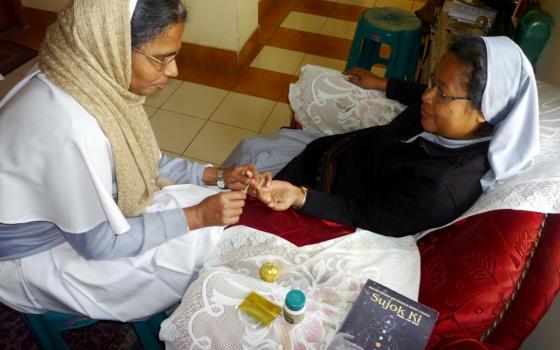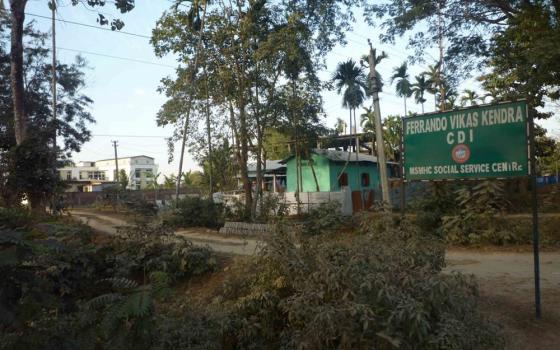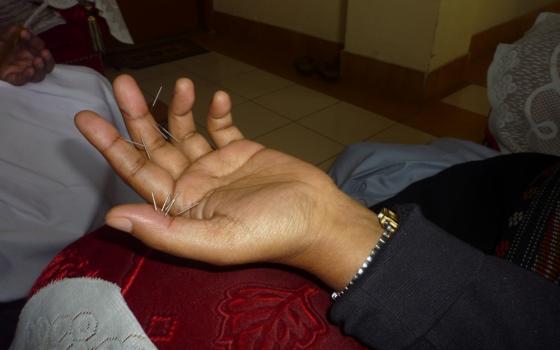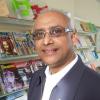Sr. Monica George is neither a doctor nor claims to be a medical practitioner of any sorts. However, on a cold January morning, the first person to come to her clinic in this northeastern Indian city was an allopathic doctor. His complaint: a chronic and persistent backache.
As George was attending to the doctor without using tools like a stethoscope or blood pressure cuff, a woman arrived from some 168 miles (270 km) east with complaints of joint pain.
On the same day a woman came from Manipur, nearly 311 miles (500 km) away, with a severe migraine headache. Before the day ended, another woman who traveled as far sought help with several complaints of her own.
In the end, they all found relief at George’s Centre for Development Initiatives, in Guwahati, which is the commercial hub of northeastern India. It is located at Ferrando Vikas Kendra, a social service center, at the back of an international airport.
Why do people with ailments, including some that might normally be treated with hospitalization or surgery, come to George?
“What I do here is treat every patient according to the Sujok acupuncture and acupressure therapy system,” the nun explained, while pressing one of the doctor’s fingers.
George said she takes a holistic approach to maintaining health and managing disease, while focusing on improving a person’s overall well-being.
One treatment George uses is a form of acupuncture, an ancient Chinese holistic therapy based on the theory that the body depends on life energy, known as qì, being in balance. (Qì is a Chinese concept, also written in English as chi, ch'i or ki.) Acupuncturists correct imbalances in the body by inserting fine needles into acupuncture points, thus maintaining or restoring good health and well-being.
According to the World Health Organization’s 1996 Acupuncture Review and Analysis of Reports on Controlled Clinical Trials, acupuncture is effective for treating 28 symptoms, diseases or disorders, while evidence indicates it may have an effective therapeutic value for many more.
Patients from all seven states in the northeastern region find healing power in George, a native of the southern Indian state of Kerala. She is a member of the Missionary Sisters of Mary Help of Christians (MSMHC), also known as the Ferrandini Sisters, the region’s first indigenous religious congregation.
Handling health emergencies
“What do you do when a child at home or a student in the hostel screams in the middle of the night with acute pain?” George asked.
It could be appendicitis or just stomach cramps, and you have no means to get the patient to the nearest primary health center or a hospital.
Or if someone complains of a severe headache during a late-night study session on the eve of an examination?
“With a little knowledge of alternative health care practices,” George said, “and a lot of faith that God can bring about healing and wellness for his suffering children through you, anyone can provide immediate relief to the suffering patient.”
George said the fee and therapy charges at the center are just 200 rupees (U.S. $3.25). A hospital charges about 800 rupees ($13) for a doctor’s fee alone. A patient at her center pays an additional 300 rupees a day for board and lodging, the nun explained.
Sujok therapy
George said Sujok therapy has overtaken other popular alternative health care practices such as Pranic healing, Reiki, and Reflexology. In Sujok therapy, the palm and foot represent all the organs/meridians in the body. “Su” means hand, while “jok” means foot, she explained. Sujok is a specialized acupuncture therapy done only in hands and feet
“Sujok can be done with other therapies also and it produces no side effects,” George said. The therapy was developed by Korean professor Park Jae Woo.
George said the therapy is safe, simple and easy to perform. The hands and feet are the locations of systems of active points that correspond to all organs and part of the body. Stimulation of these points produces a curative effect, she explained.
George attracts patients from all over the region because of her ability to speak their language. She is also able to give them individual attention.
God wants healing for all
George is the coordinator of the Centre for Development Initiatives, her congregation’s development wing, which is committed to serving marginalized communities, especially women, girls and children.
“I believe God wants all to be healed and freed of pain,” George said, pointing out wards where patients stay overnight or for a few days for treatment.
Physical and emotional stress that has become part of the lifestyle of both children and elders can eventually lead to severe illness, George said. A simple touch at the tip of one’s thumb with the index finger of any hand can give relief, she continued. “One should repeat this action to get an ultimate relief.”
For her, the ministry is “a direct way of touching people’s lives and giving them God’s love and compassion.”
She uses the Sujok acupressure and acupuncture therapy to treat a number of ailments, including high or low blood pressure, bronchitis, asthma, ulcers, constipation, migraine and vertigo.
Another healing practice is seed therapy. “When we rub a seed on the pressure points of the hand, it gives us the life and takes away the disease.” For instance, round, spherical shaped seeds of pea and black pepper can provide relief for ailments related to the eyes, head, knee joints and back problems, she said.
Smile therapy aims to strike a harmony with mind, body and soul, George said, and it can help improve one’s health and self-confidence. It is important to have God’s power in oneself for smile therapy, added George, who spends more than an hour each morning in meditation and prayer in a chapel adjacent to her chamber. “It is like charging my battery.”
George encourages her patients to learn the basics of Sujok. She organized the first Sujok workshop in northeastern India in Guwahati from Jan.16 to 26.
Sr. Pasqualina, who oversees a hostel for 200 young women attached to the Assam Don Bosco University. She uses the therapy when students complain of severe headaches or stomach aches at night. “Initially, I was anxious about what do in such emergencies,” she said. “Now, I can confidently handle the situation through quick diagnosis and applying pressure on the specific spot to restore balance.”
Sr. Monica’s story
George was introduced to Sujok therapy in an unexpected way. Suffering from an acute varicose vein infection, she sought treatment in August 2010. Dejected because her doctor expressed his inability to help her, George heard about a Sujok therapy practitioner who treated varicose vein conditions. The treatment helped and George stayed on for more than a year to learn the therapy from the village practitioner.
She was joined by her own sister, Sr. Sherly, who suffered from chronic back pain. Both are now avid Sujok practitioners.
George also took advanced training courses in Sujok in Mumbai and Bhopal and joined her congregation’s development center when she returned to northeastern India in March 2012.
She now hopes that some of her patients who attended the recent workshop will become healers through Sujok.
[Salesian Fr. C. M. Paul, Head of Mass Communication Department at Assam Don Bosco University, is a veteran journalist writing for Matters India, a news portal started in March 2013 to focus on religious and social issues in India. This article is part of a collaboration between GSR and Matters India.]



